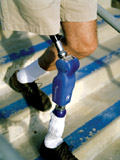 Hugh Herr, director of MIT’s Biomechatronics Group, has created the Rheo Knee, an artificial knee with an integrated microprocessor that both learns the user’s walking style and is able to quickly react and adapt to changes in terrain. The microprocessor calculates the position of the knee and the load on the limb 1000 times per second, continually learning the wearer’s gait and optimizing the proper resistance in the joint for each step.
Hugh Herr, director of MIT’s Biomechatronics Group, has created the Rheo Knee, an artificial knee with an integrated microprocessor that both learns the user’s walking style and is able to quickly react and adapt to changes in terrain. The microprocessor calculates the position of the knee and the load on the limb 1000 times per second, continually learning the wearer’s gait and optimizing the proper resistance in the joint for each step.
Herr, who had to have both of his legs amputated below the knee after a mountain climbing accident as a teenager, found himself disappointed that the traditional prosthetics that he was fitted with, while offering some mobility, did not allow him to participate in high-impact sports like running and climbing. His immediate solution was to invent a specialized foot that allowed him to begin climbing again. It was that research that inspired his work at MIT investigating how microelectronics and nanotechnology could be used in conjunction with one another to create smart artificial limbs.
Microprocessors in artificial knees are not new. They have been used for over a decade to adjust resistance during walking based on preprogrammed data to provide a more natural experience. The power of the Rheo Knee comes from the real-time learning algorithm it uses, the Dynamic Learning Matrix Algorithm (DLMA), and its physical method of adjusting resistance. The joint consists of two magnetic plates separated by a fluid made up of nanoscale iron particles suspended in a carrier fluid, known as a magnetorheological fluid (MRF). When an electric current is applied to the plates, a magnetic field is formed across the MRF causing the iron particles to form chains increasing the viscosity of the MRF and in turn increasing the resistance of the joint. The microprocessor can very quickly and smoothly change the stiffness of the joint by means of the electric current applied to the plates depending on whether it needs to immediately react to a change in terrain based on the real-time feedback it is receiving, or whether it is operating under control of its learning algorithm.
Herr’s next goal for development involves creating a true bio-interface for the knee allowing the microprocessor to read and react to signals sent between the muscles of the leg and the brain much like the system utilized by the HAL-5 Bionic Suit that was on display at IREX last week.
